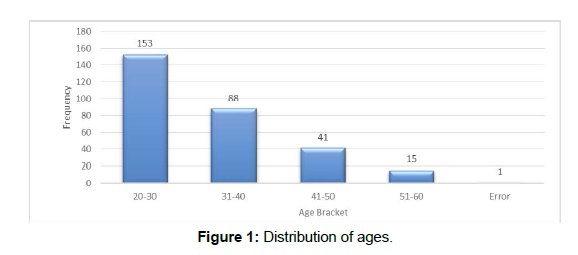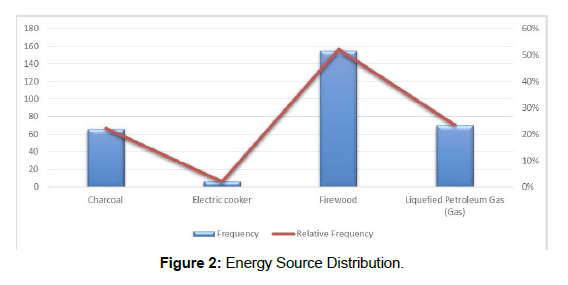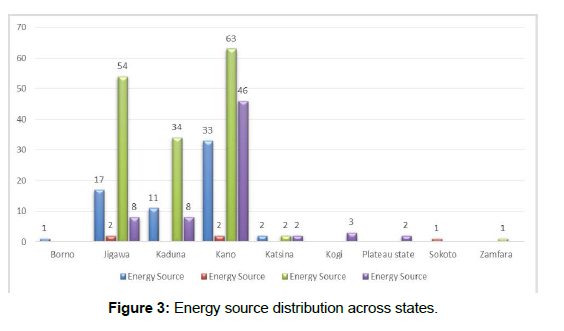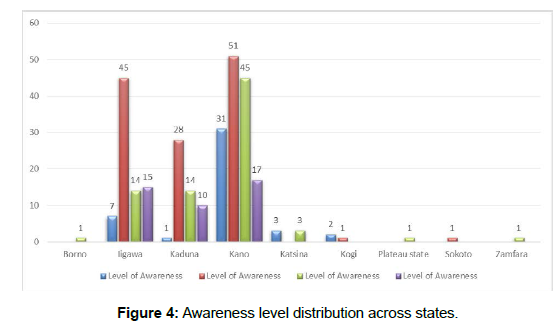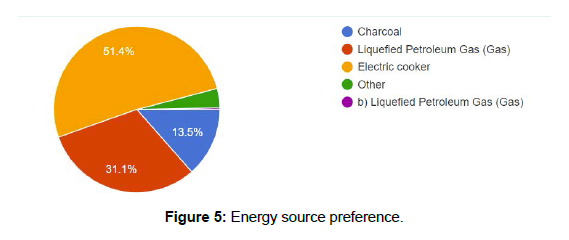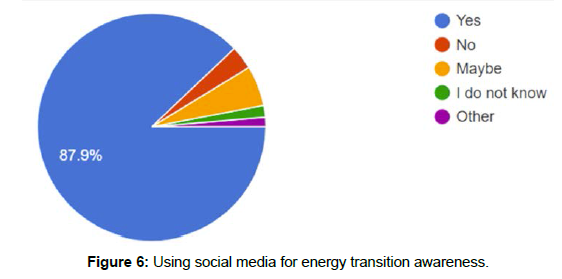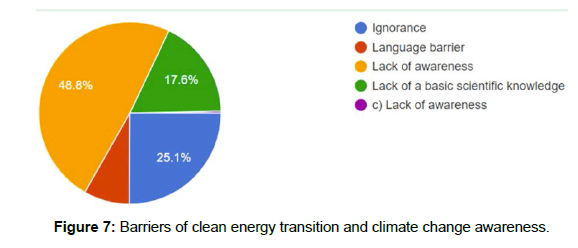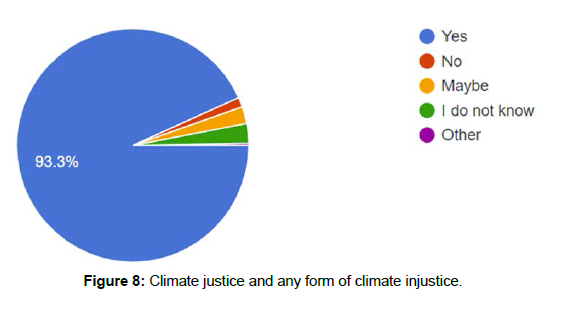An Assessment of the Level of Awareness and Knowledge Towards the Dangers of Climate Change and Energy Transition: Northern Nigeria as a Case Study
Received: 01-Jul-2022 / Manuscript No. OGR-22- 68231 / Editor assigned: 04-Jul-2022 / PreQC No. OGR-22-68231(PQ) / Reviewed: 18-Jul-2022 / QC No. OGR-22- 68231 / Revised: 21-Jul-2022 / Manuscript No. OGR-22-68231(R) / Accepted Date: 16-Jul-2022 / Published Date: 28-Jul-2022 DOI: 10.4172/2472-0518.1000250
Abstract
Access to energy remains imminent in both developed and developing countries. As it stands, each country hungrily craving for socio-economic development, in Africa or even around the world, must design its road to energytransition minding the pros and cons coupled with the previous lessons of energy transitions. In Nigeria, more than 80% living in the poorly-developed areas are energy-poor with their energy needs for heating purposes (cooking) occupying the highest share of their energy usage. The oil-producing giant of Africa is fast-becoming an epicenter of Green House Gases emissions and there will be a 16% drastic increase by 2040 if care isn’t taken. This study provides an overview of status of energy transition and climate change awareness with a focus in Northern part of Nigeria. A research questionnaire was designed to receive responses with respect to our research questions after a thorough review literature. The responses were analyzed that presented structured results. It has been identified that 51% of the people participated in this questionnaire exercise are within the age bracket of 20-30. Within, we found 52% of the people consume firewood as their source of energy. However, what is encouraging is how Gas (24%) becomes second most used source of energy though with a wide margin from firewood. Conclusively, even as the energy crisis continue to rocks in these selected states, from our findings, 51.4% of the people that responded to our questionnaire preferred to switch to electric cooker from firewood as the source of energy at home than other forms of energy, which requires huge investments especially in power infrastructure and policies. Finally, the results obtained in this study can help in addressing the gaps in awareness, frame communication and public engagement in the campaign against dangers of climate change and safest energy transition.
Keywords: Climate change; Energy transition; Nigeria
Keywords
Climate change; Energy transition; Nigeria
Introduction
In the recent years, energy transition has become a catchphrase and fast-becoming a trendy topic globally. Access to energy remains imminent in both developed and developing countries. This, however, appears within the discourse of energy transition – giving an absolute attention as a significant instrument for economic development. The need to balance wide-gap energy access differences which considerably increase the level of alternate sources of energy in cities and remotes areas today becomes spontaneously inevitable. As it stands, each country hungrily craving for socio-economic development, in Africa or even around world, must design its road to energy-transition minding the pros and cons coupled with the previous lessons of energy transitions [1].
As per the International Energy Agency (IEA, 2011), more than 80% of individuals lacking admittance to a clean and sustainable energy and also energy for heating purpose at home (cooking) live in the rustic regions, which represent shareable numbers of individuals from South Asia and Sub-Saharan Africa. Accordingly, this clearly connects the dots between absence of sustainable energy for both domestic/ industrial use and stable-income as over 75% of the poor-living people are found in poorly-developed regions that is Sub-Saharan Africa and South Asia [1].
According to J.T. Murphy [2], more than 80% living in the poorlydeveloped areas are energy-poor with their energy needs for heating purposes (cooking) occupying highest share of their energy usage. The absolute dependence on ordinary biomass as an ultimate source of energy further unveils prestigious dangers of climate change to the environment we live in (WHO, 2005), (UNDP) & (WHO, 2009).
Sub-Saharan Africa (SSA) is the residing home for global energy crisis despite the availability of the abundance, however, untapped energy resources in the region. By and by, close to 588 and 783 million people in SSA have no uninterrupted key-access to power and clean energy for cooking [3]. The circumstance even gets overpowering with regards to environmental change given the way that the modern energy framework of most SSA nations is overwhelmed by petroleum products and ordinary biomass. The economic development of the SSA also lies with continuous investment in the energy sector which could reduce the threatening poverty in the region. Progressing financial advancement in SSA will require critical interests in the sub-area’s energy area. Numerous SSA nations have understood this and have put energy at the highest point of their political plan. Likewise, developing worries about this issue have made the UN’s SDGs objectives to integrate access to clean energy SDG7.
While there is daunting energy crisis Sub-Saharan Africa and across the continent, renewable energy is found to be up-and-coming as a sustainable alternative to fossil fuels. This, using progressive policies on ground will promisingly guide African country to safest energy transition in phases. All this comes with heightened seatbacks, within Africa, small-scale photo-voltaic, biogas, and small-hydro-schemes etc,are seen by numerous individuals as an ideal methods for reducing energy crisis in rural areas [2].
Energy transition in Nigeria: The pros and cons
Seeking after a low carbon improvement technique is in this manner seen as a serious lumber of African advancement designs, and will keep on being the situation later on. Against this backdrop, low-carbon-energy-systems must occupy a critical role in the design of African advancement. The energy transition in Africa should translate and address the abject poverty in the region, the socio-economic transformation all this against the unspoken dangers of climate change. These dangers are particularly overwhelming in African rural areas, IDPs, etc [1].
The oil producing giant of Africa is fast-becoming an epicenter of the Green House Gases emissions and there will be 16% drastic increase by 2040 if care isn’t taken. Looking at the sterling effects of this emissions Nigeria is posed to forcefully expand its energy horizon in order to solve energy crisis in the country. The nation presently has a solid reliance on petroleum products. There is a need to increment renewable energy power take-up, for example, hydro, solar, biogas, and wind. Accordingly, the goal of [3] is to investigate the clear worries over Nigeria’s apparent failure to satisfy its energy need and increase the level of awareness on the approaches to accomplish reasonable advancement in Nigeria through a low-carbon energy transition. Assessed the sustainable energy transition in Nigeria by [3], the research concluded that energy for heating purpose (cooking) occupied highest share according to the model used and energy utilization in the metropolitan areas will increase and decrease in remote areas by 2050. It is further noted that by increasing the awareness of SDG7 in Nigeria will definitely lessen the energy crisis in the country.
The oil producing giant of Africa is fast-becoming an epicenter of the Green House Gases emissions and there will be 16% drastic increase by 2040 if care isn’t taken. Looking at the sterling effects of this emissions Nigeria is posed to forcefully expand its energy horizon in order to solve energy crisis in the country. The nation presently has a solid reliance on petroleum products. There is a need to increment renewable energy power take-up, for example, hydro, solar, biogas, and wind. Accordingly, the goal of [3] is to investigate the clear worries over Nigeria’s apparent failure to satisfy its energy need and increase the level of awareness on the approaches to accomplish reasonable advancement in Nigeria through a low-carbon energy transition. The excessive gas flare in the Niger Delta region of Nigeria contains an acid rain that has sulphur emissions from oil producing companies. Major policies on ground to downplay the gas flaring in the reason are unrealistic and therefore ill-fated. Moreover, more than 70% of individuals living in Nigeria provincial zones use fuel-wood and the nation utilize over 50 million tons of fuel-wood yearly. Consequently, this continuously aided environmental degradations which are assessed to happen at the pace of 350,000ha every year [4].
Additionally, the Energy Commission of Nigeria (ECN) detailed that the yearly utilization of power has expanded from 1273 GWh in 1970 to 29,573 GWh in 2012, speaking to a yearly development pace of 2.2% in 42 years. For the highest peak, power request predictability for 2030 was put at around 192,000 MW at an expected per capita utilization level of 5026 KWh. This worth will speak to a yearly development pace of power utilization at 4.7%; over twofold the rate somewhere in the range of 1970 and 2012. The ramifications of dramatically increasing the development pace of power utilization are faltering, taking into account that over the time of 1970–1999, there was staleness in limit expansion. The National Energy Policy expresses that the country will keep on connecting widely in the advancement of electric-power with the objective of making dependable power accessible to 75% of the populace by 2020, and furthermore, upgrades the energy profile for generating power [4].
Renewable energy is being fully incorporated into the global energy mix as means to address the global energy demands and also to aid a safest energy transition. The story in Nigeria is entirely different due to poor state of the energy profile, absence of sustainable legal framework, policies, etc. The progress to RE is to be viewed as a suitable answer for the previously mentioned issues since it energizes decentralized age which makes space to sidestep the bottlenecks in Nigeria’s flow power framework [5]. Observationally explored the enablers for the practical energy transition in Nigeria. It further investigates how the mission to address modern energy seatbacks and features a portion of the ramifications of the current change in Nigeria’s industrial area [6].
The Nigerian Bureau of Statistics (NBS) in the July 2018 energy sector document contended that in the first-half of 2018, day by day generated power achieved a pinnacle of 105,755 MWh on the fourteenth of March 2018, with a comparing most minimal estimation of 14,357 MWh accomplished on 30 of March 2018 (Nigerian Bureau of Statistics, 2018). As indicated by a similar report, there has been a development of clients with prepaid meters from 1.50 million by end of 2017 to 1.59 million before the finish of the primary quarter of 2018, speaking to a 6.23% expansion. This is really appalling looking at the country’s overall population of over 200 million people [6].
In developing countries like Nigeria, the energy poverty makes it difficult to have direct feelings of clean and sustainable energy, more especially, in the rural areas. Particularly, the worst case scenario is when one look at the northern Nigeria where virtually all the households in the region are fully reliant on wood-fuel as their main source of energy at home specifically when it comes to cooking. Consequently, this affects status-of-health, socio-economic development, and brings about dangers of climate injustice [5].
Energy bankruptcy in Nigeria goes past an absence of admittance to power. In 2006, fossil-fuels made up 94% of the Nigerian export drive. Expectedly 72% of Nigerians rely entirely upon wood-fuel as a cooking fuel source (NBS/CBN/NCC, 2011). The significant energyburning- through exercises in Nigeria’s families are cooking, lighting, and utilization of electrical apparatuses (Energy Commission of Nigeria, 2005) [7]. A study appointed by the World Bank in 2007 Nigeria represents around one-6th of the overall gas-flaring which thusly regurgitates about 400 million tons of carbon dioxide into the climate. Nigeria being the sixth-biggest exporter of natural gas, the energy poverty in the country remains a misery and has significantly downplayed the economic rise of the African giant nation [8].
More families in the Southern part of Nigeria use kerosene for cooking than in the Northern part of the country. Data-driven analysis by showed that despite the conspicuous existence of clean and sustainable energy, wood-fuel remains heavily a big deal in rural communities’ houses. Also, same data showed that that the energy transition from conventional wood-fuel to clean energy in northern Nigeria is not spontaneously encouraging [5].
The energy circumstance in Nigeria ought to in a perfect world courtesy the selection of clean energy choices [9]. However, arising patterns recommend a progressing change inside the energy area in Nigeria. Conspicuous models incorporate, for example, sunlight based and biogas appropriation by networks in Lagos, Delta, and Sokoto.
Things that forced Nigeria into this are: (i) Nigeria’s prevailing energy framework which is vigorously dependent on petroleum derivatives has been somehow useful throughout the long term, setting off interest for other sources of clean energy; (ii) the move towards the reception of environmentally friendly energy isn’t mostly determined by the government yet by state governments, private partnerships, and society activities. Be that as it may, there is a noteworthy variety in the reception of sustainable power among the 36 states in Nigeria [6].
Despite the empowering organization of environmentally friendly energy (renewable energy technologies) in a fossil-driven society, in any case, it is apparent that a full change to a low-carbon-energy framework in Nigeria will require dynamic support and responsibility from the political unit. In the event that this new flood of changes will add to more extensive appropriation by states and the government in Nigeria, it would need political help and consideration, acknowledgment of its monetary suitability [6].
The work of [10], discussed about a crucial need to reassesses the policy-drivers utilized in overseeing energy systems that can prompt a more perpetual energy transition. The idea of clean energy transition is to systemically move the entire schematic utilization of energy consumption in houses from unhealthy energy sources to more affordable and environmentally friendly energy systems [9].
Accordingly, it is both the portrayal of the cycle of change starting with one energy framework then onto the next and the arrangement of apparatuses and ideas to clarify and empower this change [8].
Climate change in Nigeria
Two elements brought about the climate change: natural cause (bio-geographical) and human cause (anthropogenic). The natural causes are the galactic and extraterrestrial-elements. Then again, the anthropogenic factor in environmental change includes human exercises that either discharge an enormous number of ozone depleting substances into the air that drains the ozone layer or exercises that diminish the measure of carbon ingested from the air. The human factors that emanate a lot of ozone harming substances incorporate industrialization, consuming of petroleum derivative, gas erupting, urbanization, and agribusiness. Then again, human exercises that diminish the quantity of carbon sinks are deforestation, modifications in land use, water contamination, and horticultural practices. The human elements have been demonstrated to be answerable for the continuous unequivocal environmental change or an Earth-wide temperature boost (IPCC 2007) [11].
The banter on climatic change and fluctuation is currently focused more on worldwide and territorial continents that might be set off by the climatic abnormalities of the over a wide span of time. Much as this is legitimate, the weakness and changes or ways of dealing with stress of individuals to the ideas of atmosphere is best perceived at the micro and meso-levels. All the more significantly, the worldwide chain-impacts of macro-climate inconstancy may not offer hint to how climate change influences human security at individual and collective levels. The battle for decreasing natural resources has expanded because of climate changeability ethno-religious conflicts over that possesses the land and the battle for control of abuse of mineral resources has in reality expanded particularly in the profoundly populated nations of the creating scene [12].
Most catastrophes (counting floods, dry seasons, desertification, land debasement, subsidence, and so on) are not irregular occasions without fundamental causes; they are abrupt indications of moderate yet ceaseless environmental degradation measures [11]. Climate and ecological change measures lead to changes in the bio-physical-life supportive framework including vegetation, water assets, soil, and air which establish the components that help the drawn-out manageability of life on earth. It likewise influences the socio-economic framework, and by suggestion endurance, of individuals. These progressions are driven by a blend of both common and anthropogenic causes. As of not long ago, the impacts of man’s exercises on atmosphere variety was seen as irrelevant thus the atmosphere was for the most part underestimated, and there was little felt that the atmosphere could be an issue with serious effects [12].
Climate change alludes to any change in atmosphere over the long haul, regardless of whether because of natural changeability or because of human activities. It can likewise be viewed as: “a change in atmosphere difference in atmosphere which is credited straightforwardly or otherwise to human action that adjusts the formation of the worldwide atmosphere and which is notwithstanding natural atmosphere inconstancy observed throughout equivalent time spans [13].
Climate change has become a worldwide trendy problem lately showing in varieties of various atmosphere parameters such as cloudcover, precipitation, temperature-ranges, ocean-levels, and fumepressure (Ministry of Environment of the Federal Republic of Nigeria) [13]. Climate change has been affirmed following the arrival of the fourth IPCC Assessment report. Africa will be most noticeably terrible hit by the impacts of climate change which Nigeria is important for it [14].
Nigeria, in the same way as other different nations, is presented to environmental change-actuated threats of desertification, disintegration, flooding, and other natural issues. Looking at the solid-nexus between environmental change and advancement, Nigeria is profoundly in danger in the territory of food and nourishment, neediness and craving decrease, and in particular, economic upgrade. Therefore, Nigeria’s endeavors and activities should be educated by these real factors [13].
Climate change regularly shows up exceptionally exclusive, however, in Nigeria it is genuine and this requires the logical investigation of this sort [13]. It is extended that harvest yield in Nigeria may fall by 10-20% by 2050 or even up to half because of environmental change (Jones and Thornton 2003: 54), especially on the grounds that Nigerian farming is dominatingly downpour-fed and subsequently in a general sense subject to the fancies of climate. As the individuals of Nigeria endeavor to conquer neediness and advance financial development, this wonder takes step to extend weaknesses, dissolve hard-won incomes, and truly subvert possibilities for improvement [13].
Conflict over the utilization of water-resources among various economic sectors has unfavorably influenced the hydropower plants in Kanji, Jebba, and Shiroro which is the way in to the security of power supply in the nation and speak to around 1/3 of the nation’s all out introduced power producing limit. Perpetual force blackout expands the expense of working together and hampers the speed of industrialization in the nation [14]. Nonetheless of the huge effect of climate change on rural areas who to a great extent on account of reliance on agribusiness feel the quick burden, energy utilization is even more intense in the metropolitan regions of the nation. As per World Bank sources, Nigeria registered a yearly metropolitan development pace of 4.01% in 2013 [14]. The paper noted that in spite of the fact that Lagos stakeholders have begun to react to the burdens and dangers from environmental change, these endeavors are aimless, clumsy, and divided. To be reasonable, there is a dire need to energize political will, perceive nearby activity through well-known support, recognize and assemble limits, and regulate transformation structures in all organizations and arranging levels. Although at the public level the central government in Nigeria has been a functioning member in environmental change exercises from almost immediately, the state and the local governments have been slower to follow up by virtue of political, administrative, and financial imperatives [7].
Discussion of Results
The outcome of this work is based on the statistical analysis of the received responses based on the developed questionnaire. As it is very important in the objectives of this work to drive meaningful insights from the obtained data, which will help researchers, relevant stakeholders, and students who are interested in energy transition targeting northern part of Nigeria. To begin with, Table 1 and Figure 1 shows the distribution of ages as regards to the individuals that participated in filling out the questionnaire.
Based on the Figure 1, the distribution showed that 51% of the people participated in this questionnaire exercise are within the age bracket of 20-30.
| Age Bracket | Frequency | Relative Frequency (%) |
|---|---|---|
| 20-30 | 153 | 51% |
| 31-40 | 88 | 30% |
| 41-50 | 41 | 14% |
| 51-60 | 15 | 5% |
| Error | 1 | 0% |
Table 1: Age range distribution.
Interestingly, Figure 2 will guide the reader to have an idea of where individuals participated in responding to the designed questionnaire source their energy.
As indicated in Table 2, people that consume firewood as a source of energy topped the table with 52%. However, what is encouraging is how Gas (24%) becomes second most used source of energy though with a wide margin from firewood. Electric cooker (2%) is the least and this can be attributed due to inaccessibility to electricity.
Energy Source |
Frequency | Relative Frequency |
|---|---|---|
| Charcoal | 66 | 22% |
| Electric cooker | 6 | 2% |
| Firewood | 155 | 52% |
| Liquefied Petroleum Gas (Gas) | 70 | 24% |
Table 2: Energy Source.
Table 3 shows the distribution of source of energy according to states in northern Nigeria. From the data, it can be deduced that Kano state constitute the highest number in using firewood as a source of energy for cooking at home. At the same time, the state leads in using Gas for heating purpose at home especially cooking. This effect can be attributed economic and high population factors from the state (Figure 3).
| Energy Source | ||||
|---|---|---|---|---|
| States | Charcoal | Electric cooker | Firewood | Liquefied Petroleum Gas (Gas) |
| Borno | 1 | |||
| Jigawa | 17 | 2 | 54 | 8 |
| Kaduna | 11 | 34 | 8 | |
| Kano | 33 | 2 | 63 | 46 |
| Katsina | 2 | 2 | 2 | |
| Kogi | 3 | |||
| Plateau state | 2 | |||
| Sokoto | 1 | |||
| Zamfara | 1 | |||
Table 3: Energy source distribution across states.
Figure 4
explains the distribution of level of awareness across the states with Kano leading. Impressively, Jigawa in a close mark follows up Kano in terms of level awareness of clean energy transition. It is interesting to note based on this research work that people preferred to use electric cooker as a substitute for firewood for cooking purposes at home. Figure 5 is a pie chart that shows that based on the responses received in this work.
When asked whether social media platforms can help in creating strong awareness of energy transition and climate change, over 87.9% of people agreed to that as it can be seen in Figure 6.
By asking the barrier of clean energy transition and climate change awareness in respective communities of northern Nigeria, 48.8% responded that it is due to lack of awareness as shown in Figure 7.
As can be seen in Figure 8 many people believe that there is climate justice and any form of climate injustice can drastically affect the world at large.
Conclusion
In recent years, the energy transition has become a catchphrase and a trendy topic globally. Access to energy remains imminent in both developed and developing countries. As it stands, each country hungrily craving for socio-economic development, in Africa or even around the world, must design its road to energy-transition minding the pros and cons coupled with the previous lessons of energy transitions. In Nigeria, more than 80% living in the poorly-developed areas are energy-poor with their energy needs for heating purposes (cooking) occupying the highest share of their energy usage.
This study provides an overview of status of energy transition and climate change awareness with a focus in Northern part of Nigeria. A research questionnaire was designed to receive responses with respect to our research questions after a thorough review literature. The responses were analyzed that presented structured results. It has been identified that 51% of the people participated in this questionnaire exercise are within the age bracket of 20-30. Within, we found 52% of the people consume firewood as their source of energy. However, what is encouraging is how Gas (24%) becomes second most used source of energy though with a wide margin from firewood. Electric cooker (2%) is the least and this can be attributed due to inaccessibility to electricity.
Interestingly, Table 3 shows the distribution of source of energy according to states in northern Nigeria. From the data, it can be deduced that Kano state constitute the highest number in using firewood as a source of energy for cooking at home. At the same time, the state leads in using Gas for heating purpose at home especially cooking. This effect can be attributed economic and high population factors from the state. Conversely, Figure 4 explains the distribution of level of awareness across the states with Kano leading. Impressively, Jigawa in a close mark follows up Kano in terms of level awareness of clean energy transition.
Conclusively, even as the energy crisis continue to rocks in these selected states, from our findings, 51.4% of the people that responded to our questionnaire preferred to switch to electric cooker from firewood as the source of energy at home than other forms of energy, which requires huge investments especially in power infrastructure and policies. The distribution of data in this work showed responders from Kano take the highest percentage. Therefore, future work should explore more responses from the states to drive an all-inclusive results and conclusion. Furthermore, physical data collection should be used because some of the residents aren’t familiar with internet-based questionnaire. Finally, the results obtained could help in addressing the gaps in awareness, frame communication and public engagement in the campaign against dangers of climate change and safest energy transition.
References
- Sokona Y, Mulugetta Y, Gujba H (2012) Widening energy access in Africa: Towards energy transition. Energy Policy 47: 3-10.
- Murphy JT (2001) Making the energy transition in rural east Africa: Is leapfrogging an alternative? Technol Forecast Soc Change 68: 173-193.
- Dioha MO, Kumar A (2020) Exploring sustainable energy transitions in sub-Saharan Africa residential sector: The case of Nigeria. Renew Sustain Energy Rev 117: 109510.
- Elum ZA, Momodu AS (2017) Climate change mitigation and renewable energy for sustainable development in Nigeria: A discourse approach. Renew Sustain Energy Rev 76: 72-80.
- Baiyegunhi LJS, Hassan MB (2014) Rural household fuel energy transition: Evidence from Giwa LGA Kaduna State, Nigeria. Energy Sustain Dev 20: 30-35.
- Osunmuyiwa O, Kalfagianni A (2017) Transitions in unlikely places: Exploring the conditions for renewable energy adoption in Nigeria. Environ Innov Soc Transit 22: 26-40.
- Elias P, Omojola A (2015) Case study: The challenges of climate change for Lagos, Nigeria. Curr Opin Environ Sustain 13: 74-78.
- https://www.researchgate.net/publication/335187160_Experimental_Investigation_of_Waste_Vegetable_Oil_-_Diesel_Fuel_Blends_Effects_on_Performance_of_Compression_Ignition_Engine
- Anugwom EE, Anugwom KN, Eya OI (2020) Clean energy transition in a developing society: Perspectives on the socioeconomic determinants of solar home systems adoption among urban households in southeastern Nigeria. African J Sci Technol Innov Dev 12: 653-661.
- Edomah N, Ndulue G (2020) Energy transition in a lockdown: An analysis of the impact of COVID-19 on changes in electricity demand in Lagos Nigeria. Glob Transit 2: 127-137.
- Akpodiogaga-a P, Odjugo O (2010) General overview of climate change impacts in Nigeria. J Hum Ecol 29: 47-55.
- Fasona MJ, Omojola AS (2005) Climate Change, Human Security and Communal Clashes in Nigeria.
- Ogbo A, Lauretta NE, Ukpere W (2013) Risk Management and Challenges of Climate Change in Nigeria. Journal of Human Ecology 41: 221-235.
- Olaniyi OA, Olutimehin IO, Funmilayo OA (2019) Review of climate change and its effect on Nigeria ecosystem. Int J rural dev environ health res 3: 92-100.
Indexed at, Google Scholar, Crossref
Indexed at, Google Scholar, Crossref
Indexed at, Google Scholar, Crossref
Indexed at, Google Scholar, Crossref
Indexed at, Google Scholar, Crossref
Indexed at, Google Scholar, Crossref
Indexed at, Google Scholar, Crossref
Indexed at, Google Scholar, Crossref
Indexed at, Google Scholar, Crossref
Indexed at, Google Scholar, Crossref
Indexed at, Google Scholar, Crossref
Indexed at, Google Scholar, Crossref
Citation: Inuwa HM, Usman A (2022) An Assessment of the Level of Awareness and Knowledge Towards the Dangers of Climate Change and Energy Transition: Northern Nigeria as a Case Study. Oil Gas Res 8: 250. DOI: 10.4172/2472-0518.1000250
Copyright: © 2022 Inuwa HM, et al. This is an open-access article distributed under the terms of the Creative Commons Attribution License, which permits unrestricted use, distribution, and reproduction in any medium, provided the original author and source are credited.
Select your language of interest to view the total content in your interested language
Share This Article
Recommended Journals
Open Access Journals
Article Tools
Article Usage
- Total views: 2150
- [From(publication date): 0-2022 - Nov 15, 2025]
- Breakdown by view type
- HTML page views: 1714
- PDF downloads: 436

